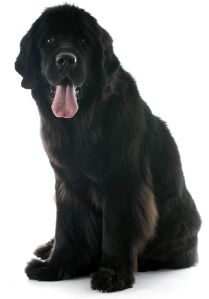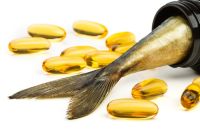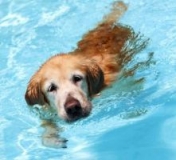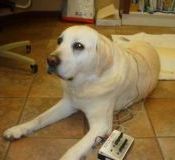Seaside Veterinary Care
Conventional and Holistic Veterinary Services Ph. 250 586-2999
Laryngeal Paralysis Occurring in Pets
What is Laryngeal Paralysis?
 Laryngeal Paralysis is a condition in which the nerves and
muscles that control the arytenoid cartilages (and so ultimately the vocal
folds) become impaired in their function. During inspiration they open and
during swallowing they close so impaired function leads to an increased risk of
aspiration of food when eating and an inability to fully oxygenate when
exercising.
Laryngeal Paralysis is a condition in which the nerves and
muscles that control the arytenoid cartilages (and so ultimately the vocal
folds) become impaired in their function. During inspiration they open and
during swallowing they close so impaired function leads to an increased risk of
aspiration of food when eating and an inability to fully oxygenate when
exercising.
It is usually an acquired disease but can be congenital, and is usually seen in large breed dogs such as Labs, Golden Retrievers, Newfies, and St Bernards. The cause is often unknown and more recently it is being associated with a more generalized degenerative neuromuscular disorder meaning that more than just the patient's breathing is affected. Patients with Laryngeal Paralysis are often older, have voice changes (hoarse bark), decreased exercise tolerance, noisy breathing, particularly on inspiration, and a cough or gag after swallowing or drinking water. A definitive diagnosis requires direct visualization of the larynx under a light anaesthesia and although surgical correction can sometimes be achieved it is often unrewarding.
Assistive Devices
If your pet is experiencing hind end weakness one of the first things you can do is look at purchasing a "Help em up Harness". They can be ordered online and may be invaluable as your pet ages.
Passive Range of Motion (PROM) and Massage
This is something you can do for your pet when you are having some quiet time together or after the more challenging exercises. Move all joints/limbs through a normal range of motion while your pet is lying down on his/her side, and gently massage the muscles. If you are unsure as to how to accomplish this I am happy to demonstrate.

Exercises
Laryngeal Paralysis is a degenerative disease and the most helpful thing you can do is to try and keep your pets muscles as strong as possible. Exercises can be done at home. The exercises I would encourage you to try are:
- Cookies to the Head and Hip, these help with flexibility.
- Side-stepping, try the modified sideways walking i.e. don't try lifting any limbs just gently encourage a sideways walk, this helps to strengthen the muscles in the hind end.
- Partial Sit-Stand, these are fun and help to strengthen the gluteal muscles which are so important for the hind end.
- Cavaletti's, great for proprioception.
- Weight Shifting, great for balance and helping maintain muscle mass. Don't try the advanced exercise but you can do Single Leg Lifts.
Supplements

Some of the suggestions you may already using but if not then try:
- Omega-3's (Fish or Coconut oil)
- Cartrophen injections (Polyglycosaminoglycans....good for pain and joint health)
- Glucosamine and MSM
- Coenzyme Q10
- Vitamin B Complex +/- Vitamin B12 injections
Hydrotherapy
 Gentle
controlled work in the water can be very helpful but remember these pets
can tire easily so don't allow them to go far or go without supervision.
The underwater treadmill is a great tool.
Gentle
controlled work in the water can be very helpful but remember these pets
can tire easily so don't allow them to go far or go without supervision.
The underwater treadmill is a great tool.
Acupuncture
 This
is very individual to each pet but regular acupuncture may be helpful
with mobility and breathing so it is always a valid option.
This
is very individual to each pet but regular acupuncture may be helpful
with mobility and breathing so it is always a valid option.